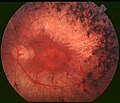GLAM/Newsletter/February 2012/Contents/Open Access report
Appearance
|
Open Access report
Mexican waves performed by Asian Giant Honeybees drive hornets away from their nest. 
A juvenile Brookesia micra on the head of a match. 
'Paedophryne amauensis, the smallest known vertebrate. 
A logo celebrating the tenth anniversary of the Budapest Open Access Initiative in 2012, featuring the Széchenyi Chain Bridge in Budapest.
Ten years "Open Access"; chameleons, bees, copyright
In February, the Wikimedian in Residence on Open Science project focused on improving the infrastructure for WikiProject Open Access. Tool testing continued, though on a lower scale.
- A News section provides project updates. The February entries were:
- February 29: The frog Paedophryne amauensis - originally described in PLoS ONE in January - is featured on the main page of the Simple Wikipedia under Did You Know (traffic stats). See also the gallery of earlier appearances on the Main Page of other Wikipedias.
- February 29: A video from a PLoS ONE article - showing Mexican waves performed by Asian Giant Honeybees that drive hornets away from the nest - is featured under Media of the day on Commons. Traffic stats.
- February 25: A video on copyright transfer agreements was featured under Media of the day on Commons, then taken down as a suspected copyright violation. Traffic stats.
- February 21: en:Copyright transfer agreement started and nominated for DYK. Needs review. Traffic stats.

- February 19: The article Brookesia micra - about a new chameleon species described on February 14 in PLoS ONE - is featured under DYK. Traffic stats.
- February 14: 10th anniversary of the Budapest Open Access Initiative going public. That article needs a lot of work. Blog post on the occasion. Traffic stats.
- February 13: Wikimedia Germany approved a project to help academic publishers optimize their workflows for reuse of materials on Wikimedia projects

- February 10: The frog Paedophryne amauensis, originally described in PLoS ONE in January, is featured on the main page of the Polish Wikipedia (traffic stats). See also the gallery of earlier appearances on the Main Page of other Wikipedias.
- February 4: en:Template:OA-ness started (demo) as spin-off of foundation-l discussion. Needs feedback - just like the nascent Open Access policy of the WMF.
- February 1: WikiProject Open Access is featured in the January 2012 issue of This month in GLAM. Traffic stats.
- The project now has 8 members (up from 5)
- The project now has 144 assessed articles (up from 109):

| Open access articles by quality and importance | ||||||
|---|---|---|---|---|---|---|
| Quality | Importance | |||||
| Top | High | Mid | Low | NA | Total | |
| B | 5 | 7 | 2 | 2 | 16 | |
| C | 12 | 6 | 7 | 4 | 29 | |
| Start | 2 | 10 | 17 | 21 | 50 | |
| Stub | 4 | 2 | 4 | 12 | 22 | |
| List | 1 | 1 | ||||
| NA | 2 | 24 | 26 | |||
| Assessed | 24 | 27 | 30 | 39 | 24 | 144 |
| Total | 24 | 27 | 30 | 39 | 24 | 144 |
Open Access File of the Day
The blogging series on the Open Access File of the Day ended on February 14 - the tenth anniversary of the Budapest Open Access Initiative. WikiProject Open Access now features the Open Access File of the Day of the current day and of the three preceding days on its main page, and the Open Access File of the Day can be embedded on user pages. The following files have been featured in February:
-
February 29: Adult male Hapalomys delacouri rat.
-
Februrary 28: Fluorescence microscopy of wound healing in Drosophila.
-
February 27: A female Brookesia desperata with two freshly laid eggs.
-
February 26: Two-photon excitation microscopy of mouse intestine.
-
February 25: The fundus of a patient with retinitis pigmentosa.
-
February 24: The holotype adult skull of Pachycephalosaurus reinheimeri.
-
February 22: Coronal section of a human brain with cortical edema.
-
February 21: A love dart of the snail Monachoides vicinus.
-
February 20: A leaf-cutter ant.
-
February 19: Nuclei in the worm C. elegans.
-
February 18: The parasitic wasp Neoneurus vesculus ovipositing in workers of the ant Formica cunicularia.
-
February 17: The geodesic architecture of viral capsids.
-
February 16: Song-learning pathways in birds.
-
February 15: A juvenile Brookesia micra standing on the head of a match.
-
February 14: A deep-sea community living nearby a hydrothermal vent. Has annotations.
-
February 12: Zebra finches
-
February 11: A Golay cell
-
February 10: Identical twins may look different
-
February 9: Northwestern Yunnan, China
-
February 8: Embryo and placenta
-
February 7: The rove beetle Dalotia coriaria
-
February 6: Pepper mild mottle virus in action
-
February 5: The louse Fahrenholzia pinnata
-
February 4: The small dinosaur Araripesuchus wegeneri
-
February 3: Wolbachia inside a fruitfly cell
-
February 1: The blood-feeding sandfly Lutzomyia longipalpis, transmitter of Leishmaniasis
+ Add a commentDiscuss this story
To follow comments, add the page to your watchlist. If your comment has not appeared here, you can try .
No comments yet. Yours could be the first!





























